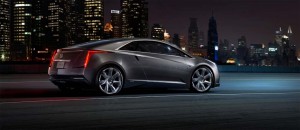General Motors has apparently reversed course and now plans to add a second plug-in hybrid to its U.S. product line-up, this one targeting the luxury market where pricing could be less of a concern than it has become for the more mainstream Chevrolet Volt.
The new model, dubbed Cadillac ELR, is based on the wildly popular Caddy Converj, perhaps the biggest hit of the 2009 Detroit Auto Show. Details including price and timing have not been released, though industry sources tell TheDetroitBureau.com that the new model would likely be launched well before mid-decade and carry a sticker price pushing towards the high $40,000 mark – reflecting significant added content beyond what’s now offered in the plebian Chevy plug-in.
It’s not clear whether the ELR will add significantly to GM’s overall sales goals for its so-called Voltec plug-in hybrid technology or will simply take up some of the already-planned capacity that had until now been assigned to the Volt and a second gas-electric model, the Opel Ampera. Together, they’re expected to generate 16,000 sales in 2011, with production rising to 40,000 next year.
According to a GM release, the Cadillac ELR will share the same extended-range electric vehicle driveline as Volt and Ampera. That means that under all but the most demanding circumstances the wheels are turned solely by an electric motor. Power initially comes from a T-shaped lithium-ion battery pack, but after the batteries are discharged the vehicle automatically switches to an onboard 4-cylinder gas engine.
Currently, Volt has 16 kilowatt-hours of batteries giving it about a 35-mile range in electric mode under normal conditions – though that drops – sometimes sharply — under hard acceleration or if electric heat or air conditioning is used. By the time ELR launches it may get a next-gen battery pack that would either be smaller, lighter and less expensive or which could extend the vehicle’s electric-only range.
Recalling the launch of the Converj concept, Caddy marketing chief Don Butler noted it “generated instant enthusiasm.” That was particularly true with the luxury brand itself, Cadillac officials arguing hard to add the plug-in to their line-up. But when it didn’t appear they could make the right business case, GM managers canceled the program – despite the fact that CEO Dan Akerson is an avowed fan of battery propulsion.
Exactly why the company has reversed itself and approved the ELR is uncertain, though a well-placed source speculated GM may be worried that the mainstream market for plug-ins may be smaller than forecast because of price concerns. That was cited in a new study released this week by CNW Marketing, which warned that even the most EV-friendly of buyers appear to be losing interest in the Volt, in large part due to its hefty cost. (Click Here for more on the CNW study.)
Chevy has tried to reduce resistance by lowering the price of the Volt from $41,000 for the original 2011 model to just $39,995 for 2012 – even as arch-rival Nissan Leaf’s price is increased for the upcoming model-year.
Caddy is not saying what the ELR stands for, though it fits in with the brand’s current nomenclature – while the battery car’s edgy design also echoes the Art and Science styling of current models like the Cadillac CTS.
The brand is getting a number of new offerings in its bid to become a more formidable player in the crowded and competitive luxury market – including the upcoming ATS compact sedan and big XTS flagship.
Meanwhile, as TheDetroitBureau.com also reported this month, GM has signed a new deal with battery maker A123 to supply lithium-ion packs that will be used in a new line of pure battery-electric vehicles likely to start rolling out around 2014. Batteries for the Volt and ELR, meanwhile, are being provided by Korea’s SG Chem.

